IDENTIFICATION AND IMPORTANCE OF POISONOUS PLANTS FOR LIVESTOCK IN INDIAN SCENARIO
Shraddha Nety1, R.C. Ramteke2, Nidhi Rawat3, Vandana Bhagat4 and Kranti Sharma5
Department of Veterinary Pharmacology and Toxicology, College of Veterinary Science and Animal Husbandry, Dau Shri Vasudev Chandrakar Kamdhenu Vishwavidyalaya (DSVCKV) Anjora, Durg – 491001 (Chhattisgarh), INDIA
INTRODUCTION
Toxic plants affecting small ruminants are of major concern for both the practicing
veterinarian and farmer. Numerous poisonous plants have known to cause negative
impact on the livestock industry. Although grazing is considered as normal routine in
livestock management, it exposes the animals to a variety of poisonous plants
particularly when there is reduction in fodder availability. Ingestion of poisonous plants
by animals produces toxic effects like physical upset, loss of productivity and even
death. There are several factors that contribute to plant poisoning like season and
weather conditions, feeding of livestock with poor quality roughage, transportation and
handling. Poisoning can occur either by accidental ingestion of plants with usual feed or
by willful consumption of toxic plants when pastures are dry.
Animals which are already under nutritional stress are more susceptible to plant
poisoning. Good practices of grazing with proper observation of grazing animals along
with intense knowledge about poisonous plants and strategic approaches to therapy
helps to resolve the problem. Plants that are seen in a particular geographical region
may not be found in other regions due to difference in geographical distribution.
Invasion of poisonous plants into non-native areas affect this distribution. For most of
the plant poisoning cases the treatment is general with symptomatic and supportive
therapy since there is no antidote for most of the toxins. The ultimate goal of treatment
should be removal of toxins from the body. Treatment includes administration of
activated charcoal and stabilization of the animal with fluid and electrolytes. Removing
the poisonous weeds from the grazing area and providing good quality forages reduces
the risk of plant poisoning.
WHY IT IS IMPORTANT TO IDENTIFY
The majorly described predisposing factors for the occurrence of plant poisoning were feed shortage, nutritional deficiency and excessive consumption. Animal poisoning due to plants constitutes one of the most important health problems to livestock in countries with extensive production system (Bah M; 2013). Livestock health disorders due to phytopoisoning cause a significant morbidity and mortality in animals in their areas. Some specific area of Chhattisgarh region has lower rainfall and limited plant coverage but rich in livestock production potential. Accordingly, the common poisoning seasons complained were at the end of rainy season (August-September) and during drought time (February-May). This finding is in agreement with the similar reports from (Abriham K;2013). According to this study, a total of 11 plants were identified and documented as poisonous effect on livestock. The poisonous plants frequently described by the respondents were Parthenium hysterophorus, Lantana camara, Acacia abyssnica, Sorghum bicolar, Ipomea carnea and Datura stramonium. Dereje et al., (2014 and 2015) have documented Parthenium hysterophorus, Lantana camara, Sorghum bicolar as the most frequently implicated poisonous plants which are in agreement with the current finding.
WHY URGENT NEED TO TREATMENT PLANT POISONING
Castor oil plant or Castor bean (Ricinus communis)
Ricinus communis is an extremely toxic plant that is commonly known as castor oil plant
or castor bean. The toxic principle present in this plant is a water-soluble ribosome-
inactivating protein called ricin which is mostly concentrated in its seeds. Ricin is a heat
labile protein which can be destroyed during the extraction process. The leaves and
fruits of the plant contain an alkaloid, ricin which can stimulate the central nervous
system (Audi et al, 2005). Mechanism of toxicity is mainly due to the inhibition of
protein synthesis.
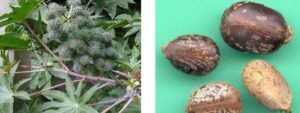
Fig. 1: Ricinus communis plant, Fruits (Left) and Seeds (Right) |
The initial toxicity signs include nausea, gastro-intestinal
irritation, abdominal pain, diarrhoea, tenesmus, dehydration, cessation of rumination,
muscle twitching, dullness of vision, convulsions, weakness, profuse watery diarrhea and dehydration within 6-24 h. Biochemical examination reveals a high packed cell volume and increased levels of serum creatine kinase, aspartate aminotransferase (AST), blood urea nitrogen (BUN) and creatinine value and hyperbilirubinemia. Necropsy lesions include gastroenteritis, necrosis and haemorrhage in heart and kidney.
Management of Ricinus communis poisoning includes general and symptomatic
therapy as there is no antidote against ricin. Administration of activated charcoal to
adsorb toxins would be helpful. Intravenous hydration and fluid replacement is
necessary to combat dehydration and fluid loss in affected animals.
Rosary Pea or Bead Vine or Coral Bead Plant or Crab’s Eyes (Lantana camara)
It is commonly grown as an ornamental plant where the seeds are used in
jewelry and handicrafts. The toxic principle of the plant is a lectin called abrin which is
present in its seeds. Mechanism of action is by inhibition of protein synthesis which is
mediated through ribosomal subunit inactivation. Cattle are more prone to abrin
poisoning compared to other animal species.
Clinical signs associated with oral ingestion includes gastroenteritis with
vomiting and diarrhoea which then leads to circulatory collapse. Animal may exhibit
local signs such as conjunctivitis and dermatitis.
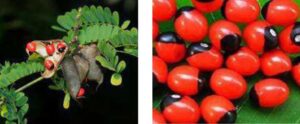
Fig. 2: Abrus precatorius plant and seed (Right) |
Management of abrin poisoning can be done by administering activated charcoal at the total dose of 250-500g in large ruminants. Anti-abrin serum can also be given as a
specific antidote. Administration of saline purgatives at the rate of 100-200g and
alkalinization of urine will help to excrete the absorbed toxins. Symptomatic treatment
along with fluid therapy will facilitate faster recovery.
Oleander or Oleana or Rose Bay (Nerium oleander )
Nerium oleander is a flowering shrub commonly grown as an ornamental plant in
gardens and parks. Oleander is known to be poisonous to animals (Frohn and Pfander, 1983). Nerium oleander and Thevetiam peruviana (yellow oleander). The toxic principle present in oleander are mostly cardiac glycosides which includes oleandrin, folinerin and digitoxigenin that exhibits cardiotoxicity. The toxic effects exhibited by oleander includes
ventricular arrhythmia which leads to ventricular fibrillation and finally death of the
animal. Initial stages of intoxication in ruminants include ruminal atony with moderate
tympany (Aslani et al., 2004). Other clinical signs include abdominal pain, frequent
urination, bradycardia, tachycardia, depression, and weakness.

Fig 3: Nerium Oleander plant with flowers
Lantana weed or Wild sage or Red sage ( Lantana camara)
Lantana camara is the most popular ornamental garden plant.The
toxic effect is due to the presence of some triterpene ester metabolites, lantadene A and
B. The drastic effect of lantana poisoning includes cholestasis
and hepatotoxicity due to the continuous absorption of toxins from the rumen. General line of treatment includes administration of laxatives to remove toxins
from the body (Blood et al., 1983). Manual removal of the toxic rumen contents
enhance the recovery. Administration of activated charcoal can be done to adsorb the
toxins in the rumen and helps to prevent further absorption. Antihistaminic and
antibiotics should also be administered. Moving the animal into the shade helps to
prevent the development photosensitive dermatitis (Blood et al, 1983).
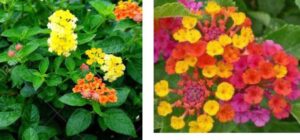
Fig. 4: Lantana camara plant and flower (Right) |
Cyanogenic plants (Sorghum Bicolar)
The common cyanogenic plants include Sorghum, Sudan grass, Corn, Lima beans,
Cherry, Apple, Peach and Apricot. The toxic principle in cyanogenic plants are
cyanogenic glycosides like amygdalin, prucin dhurrin and
taxiphyllin. These glycosides as such are not toxic but they become toxic when they get
hydrolysed in the body. Processing of the plants like freezing, chopping or chewing
render them more toxic due to release of enzymes (Gracia and Shepherd, 2004).
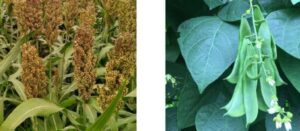 |
Fig. 5: Sorghum or Sorghum bicoIor Left) and Lima beans or Phaseolus
lunatus (Right)
Clinical signs are exhibited within minutes to a few hours. Death in animals
usually occurs within 2 hours after consuming the lethal dose of cyanogenic
plants.Laboured breathing, dyspnoea, restlessness, tremors, terminal clonic convulsions
and opisthotonus are the clinical signs shown by the intoxicated animal. Initially the
mucous membranes are bright and cherry-red color due to oxygen abundance in blood.
Later it turns cyanotic due to hypoxia. Then the animal enters into coma and die if not
treated promptly.
Treatment involves intravenous administration of a mixture containing 1 ml of
20% sodium nitrate and 3 ml of 20% sodium thiosulfate, given at a dose rate of 4 ml
mixture per 45kilogram body weight. In sheep, the recommended doses of sodium
thiosulfate @ 660 mg/ kg can be given in combination with conventional doses of
sodium nitrite @ 6.6 mg/ kg.
Carrot grass or congress grass or Gajar ghas, famine weed ( Parthenium hysterophorus)
It is an annual herb. It is erect, branched, aromatic plant with a deep tap root.
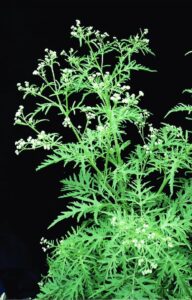
Fig.6: Parthenium plant ( a and b)
All the parts of this plant including trichomes and pollen are poisonous. Toxic principles are “sesquiterpene lactones” which cause allergic dermatitis. Major sesquiterpene lactone of parthenium weed is “Parthenin” which is photodynamic agent and causes primary photosensitization. Clinical signs, Initially diarrhoea followed by cutaneous lesions characterised by itching, erythematous eruptions on tip and base of ears, neck, sides of thorax, abdomen. Treatment: Shifting of animal to normal fodder. Symptomatic treatment of dermatitis, antiprurits, antihistamines and antibiotics, liver tonic to rejuvenate damaged liver.
Cotton plant (Gossypium herbaceum)
It is a sub-shrub, its stem thick and rigid, leaves horizontally placed. Leaves and twigs are sparsely hairy and rarely glabrous.

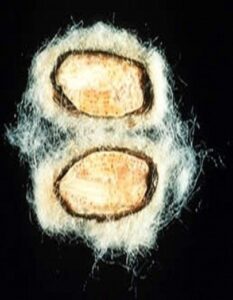
Fig.7: Cotton plant and seed ( a and b)
cotton seed and cotton seed meal toxic principle include, polyphenolic pigment produced in high concentrations in the seeds of cotton plant. It is cardiotoxic, Clinical signs, Anorexia, weakness, pulmonary edema and dyspnoea in pigs and horses due to myocardial degeneration and subsequent heart failure. Cardiac degeneration particularly in pre-ruminant calves. Cattle exhibit anaemia, haemolysis, dyspnoea, oedema of brisket, depression and death. Treatment: Remove the source at once, anti-arrythmic drugs may be tried.
Indian Tobacco (Lobelia Inflata)
It is an annual or biennial herbaceous with stems covered in tiny hairs. Its leaves are usually long and are ovate, toothed and alternately arranged.

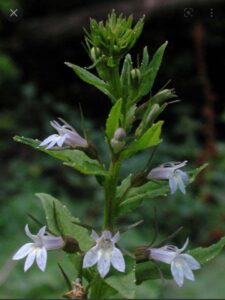
Fig. 8: Indian Tobacco plant and flowers ( a and b)
All the parts of the plant are involved in toxicity. Its toxic principle is a pyridine alkaloid- lobeline. Their primary action is activation and then blockade of nicotinic acetylcholine receptors. Activation of nicotinic receptors in the cortex, thalamus, interpenduncular nucleus, and other locations in the CNS accounts for coma and seizures. Clinical signs, Nausea, emesis, mydriasis, muscle tremors, weakness, paralysis and death. Treatment Gastrointestinal detoxification and others.
Besharam or behaya or bush morning glory (Ipomea carnea)
It is a large straggling shrub widely grown in many parts as a hedge and for green manuring. This flowering plant has heart-shaped leaves that are rich green and 5-6 inches long.

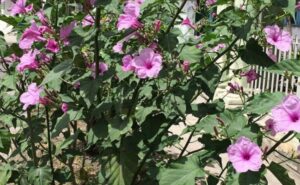
Fig. 9: Ipomea Cornea flower and whole plant ( a and b)
The toxic principles of I. carnea are the alkaloids swainsinine and calystegines. The plant contains the alkaloids swainsonine and calystegines, which inhibit key cellular enzymes and cause systemic cell death.
Clinical signs, salivation, dairrhoea, mydriasis, shivering, incordination, staggering gait, prostration, ataxia, paralysis of limbs, lateral recumbency, hypotension and death.
Treatment- Remove the source of poisoning., saline purgatives to remove, activated charcoal to facilitate the removal of toxic principles. Sodium acid phosphate can be administered to overcome hypophosphataemia.
Dhatura or Jimsonweed or devil’s snare. (Datura stramonium)
It is an erect annual herb forming a bush upto 1-1.5m tall. The leaves are soft , irregularly undulate, and toothed. The fragrant flowers are trumpet-shaped, white to creamy or violet and long.
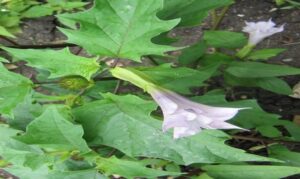
Fig. 10: Dhatura plant and Flower
All the parts of the plant are toxic. These contain atropine like alkaloids. Clinical signs: Depression, dryness of mouth and mucous membrane, thirst, anorexia, dysphagia, ruminal atony, constipation, blindness, tachycardia, hyperpnoea, restlessness, delirium by convulsions, motor and sensory paralysis, respiratory depression, relaxation of sphincters and death from asphyxia. Treatment: No specific antidote available. Only symptomatic treatment, emetics or gastric lavage, followed by activated charcoal, demulcents and saline purgative. parasympathomimetic agents like physostigmine, pilocarpine etc. Artificial respiration with a mixture of oxygen and carbondioxide may be quite helpful.
Madar or milkweed (Calotropis gigantea)
It is a large and tall shrub and has clusters of waxy flowers that are either white or lavender in colour. The plant has oval, light green leaves and milky stem.

Fig. 11: Madar plant and flower
All the parts of the plant are toxic. It contain calotroxin, calactin, uscharin, gigantin clinical signs Irritation to skin and mucous membranes, acute gastroenteritis and cardiotoxicity. Treatment: No specific antidote available. Only symptomatic treatment, emetics or gastric lavage, followed by activated charcoal, demulcents and saline purgative.
Table 1 – Brief information on the major plants responsible for toxicity in ruminants
| Plant | Active
compounds |
System affected | Treatment |
| Lantana | Lantedene A | Hepatotoxic | Liver supplements |
| Camara | B | Fluids and electrolytes | |
| Abrus | Abrin | Cytotoxic | Symptomatic and |
| Precatorius | Supportive care | ||
| Nerium | Oleandrin, | Cardio toxic | Anti-digoxin fab |
| Oleander | Thevetin | fragments, Atropine, | |
| Beta blockers | |||
| Castor bean | Ricin, Ricin, | Gastrointestinal | Anti ricin serum , Symptomatic and |
| (Ricinus | toxicity | supportive care, | |
| communis) | Activated charcoal | ||
| Corn, | Cyanogenic | Cytotoxic anoxia | Sodium nitrate and |
| Sorghum, | Glycosides | Sodium thiosulfate | |
| Tapioca, | |||
| Ipomea carnea
|
Alkaloids LSD | Lumbar paralysis |
The affected animals should be administered hepatotonics, nerve tonics and haematinics
The affected animals
should be administered hepatotonics, nerve tonics and haematinics |
| Parthenium hysterophorus
|
Parthenin | Depigmentation in patches | Antipruritics and antiseptics |
| Datura Stramonium
Datura SStamonium |
Atropine like alkaloids | Tachycardia, ruminal
atony |
Physostigmine, pilocarpine |
|
|
Alkaloids | ||
CONCLUSION
Numerous poisonous plants have known to cause negative impact on the
livestock industry. Grazing is considered as normal routine in livestock management, but
it exposes the animals to a variety of poisonous plants particularly the poisonous plants with higher botanical frequency were Parthenium hysterophorus and ricinus communis due to feed shortage, nutritional deficiency and excessive consumption are the major predisposing factors for the occurrence of plant poisoning. The common poisoning seasons were at the end of rainy season and during drought time. For most of the plant poisoning cases the treatment is general with symptomatic and supportive therapy since there is no antidote for most poisons. Delay in treatment and unattained cases may lead to loss of animal, partially or completely. Toxin specific antidotes are available for treating several plant toxicity.
Unfortunately, due to the high costs and scarce availability of these antidotes
veterinarians may not have ready access to all of those that are clinically useful in
managing plant toxicity. This study showed that caprine and bovine followed by camels and ovine were the most frequently poisoned animals. Hence, Phyto poisoning is commonly occurring and challenging health of livestock in the area. Therefore, proper range management should be practiced
References
Aslani, M. R. (2004). Poisonous plants of Iran and their effects on animals. 1st. Edn.,
Mashhad, Mashhad University Press., 210-212.
Audi, J., Belson, M., Patel, M., Schier, J. and Osterloh, J. (2005). Ricin poisoning: a
comprehensive review. Jama, 294 (18): 2342-2351.
Bah, M. (2013). The importance of Traditional Veterinary Medicine (TVM) in Animal health Programs In: FAO Corporate Document Repository, FAO.
Blood, D. C., Radostits, O. M. and Henderson, J. A. (1983). Veterinary Medicine, Bailliere
Day, P., J., Pinheiro, T. J., Roberts, L. M. and Lord, J. M. (2002). Binding of ricin A-chain to
negatively charged phospholipid vesicles leads to protein structural changes and
destabilizes the lipid bilayer. Biochemistry, 41(8): 2836-2843.
Abriham, K., Tilahun, Z., Dereje, A. and Girma, K. (2005). Assessment of poisonous plants to livestock in and around nekemte area, east wollega zone of oromia regional state, western ethiopia. Nat Sci. 13(8): 8-13.
Dereje, A., Tariku, J., Teshale, S., Ashenafi, F. and Takele, B. (2014). Assessment of plant and chemical poisoning in livestock in central Ethiopia. J. Environ Anal Toxicol.4: 215.
Dereje, A., Tadesse, B. and Sultan, A. (2015). Survey of toxic plants in livestock at horro gudurru wollega zone, western ethiopia. J Biol Agric Healthcare. 5(1): 101-6.
Everest, J. W. T.A. Powe J. and Freeman. J.D. (2005). Poisonous plants of the Southeastern United States. Alabama Cooperative Extension. ANR-975.
http://www.aces.edu/pubs/docs/A7ANR-0975/ANR-0975.pdf (accessed 25 Jan.
2013).
Frohn, D., Fander, P. and H. J. (1983). A colour atlas of poisonous plants. 1st. Edn., London, Wolf Science Book. 47-48.
Gracia, R. and Shepherd, G. (2004). Cyanide poisoning and its treatment.
Pharmacotherapy: The Journal of Human Pharmacology and Drug Therapy,
24(10): 1358-1365.
Joubert, J., P. J. (1989). Cardiac glycosides. In: P.R. Cheeke (ed.), Toxicants of Plant Origin,
vol. II, (CRC Press, Boca Raton, FL) 61-96.
Present Address of all the author
- Shraddha Nety (Corresponding author)
Associate Professor, Department of Veterinary Pharmacology and Toxicology
College of Veterinary Science and A.H. Anjora, Durg (C.G.)
Email: dr_shraddha20@yahoo.com
- Dr. Aalisha
M.V.Sc student, Department of Veterinary Pharmacology and Toxicology
College of Veterinary Science and A.H. Anjora, Durg (C.G.)
Mo. 7987586326, 9109710736
Email: iamaalisha0412@gmail.com
- R.C. Ramteke
Assistant Professor, Department of Animal Nutrition
College of Veterinary Science and A.H. Anjora, Durg
Mo. 9329583360 Email: rcr_2009@rdiffmail.com


